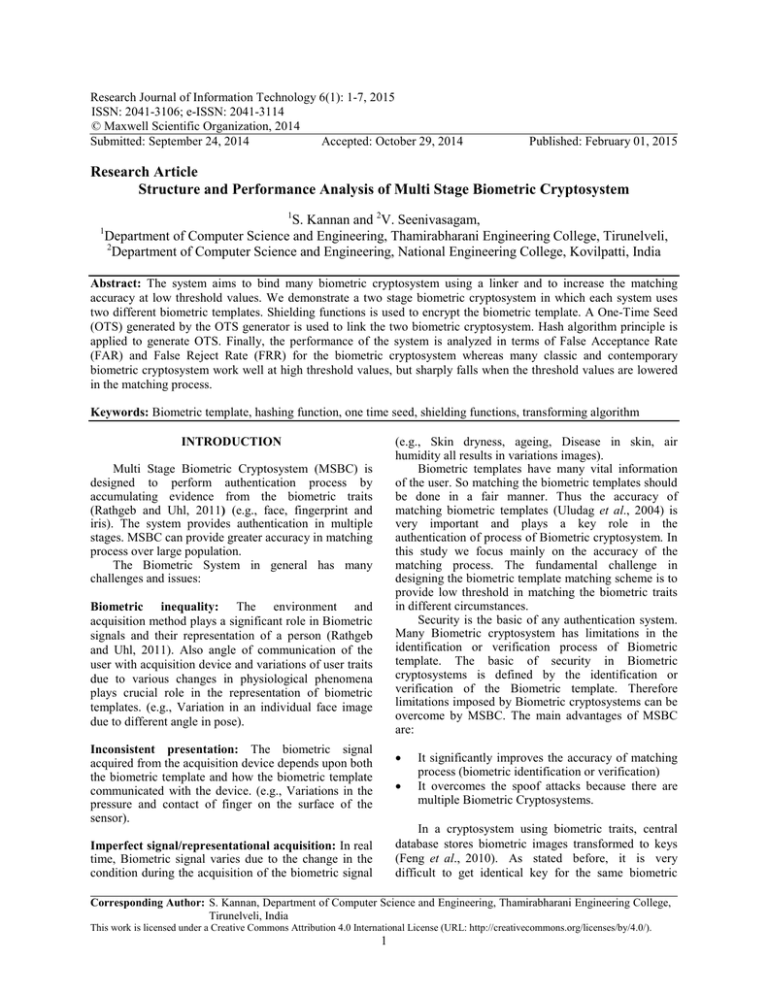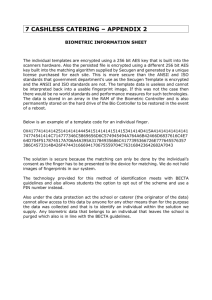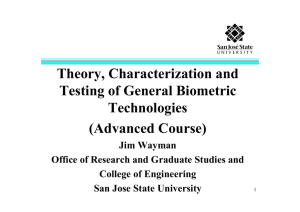Research Journal of Information Technology 6(1): 1-7, 2015
advertisement

Research Journal of Information Technology 6(1): 1-7, 2015
ISSN: 2041-3106; e-ISSN: 2041-3114
© Maxwell Scientific Organization, 2014
Submitted: September 24, 2014
Accepted: October 29, 2014
Published: February 01, 2015
Research Article
Structure and Performance Analysis of Multi Stage Biometric Cryptosystem
1
1
S. Kannan and 2V. Seenivasagam,
Department of Computer Science and Engineering, Thamirabharani Engineering College, Tirunelveli,
2
Department of Computer Science and Engineering, National Engineering College, Kovilpatti, India
Abstract: The system aims to bind many biometric cryptosystem using a linker and to increase the matching
accuracy at low threshold values. We demonstrate a two stage biometric cryptosystem in which each system uses
two different biometric templates. Shielding functions is used to encrypt the biometric template. A One-Time Seed
(OTS) generated by the OTS generator is used to link the two biometric cryptosystem. Hash algorithm principle is
applied to generate OTS. Finally, the performance of the system is analyzed in terms of False Acceptance Rate
(FAR) and False Reject Rate (FRR) for the biometric cryptosystem whereas many classic and contemporary
biometric cryptosystem work well at high threshold values, but sharply falls when the threshold values are lowered
in the matching process.
Keywords: Biometric template, hashing function, one time seed, shielding functions, transforming algorithm
(e.g., Skin dryness, ageing, Disease in skin, air
humidity all results in variations images).
Biometric templates have many vital information
of the user. So matching the biometric templates should
be done in a fair manner. Thus the accuracy of
matching biometric templates (Uludag et al., 2004) is
very important and plays a key role in the
authentication of process of Biometric cryptosystem. In
this study we focus mainly on the accuracy of the
matching process. The fundamental challenge in
designing the biometric template matching scheme is to
provide low threshold in matching the biometric traits
in different circumstances.
Security is the basic of any authentication system.
Many Biometric cryptosystem has limitations in the
identification or verification process of Biometric
template. The basic of security in Biometric
cryptosystems is defined by the identification or
verification of the Biometric template. Therefore
limitations imposed by Biometric cryptosystems can be
overcome by MSBC. The main advantages of MSBC
are:
INTRODUCTION
Multi Stage Biometric Cryptosystem (MSBC) is
designed to perform authentication process by
accumulating evidence from the biometric traits
(Rathgeb and Uhl, 2011) (e.g., face, fingerprint and
iris). The system provides authentication in multiple
stages. MSBC can provide greater accuracy in matching
process over large population.
The Biometric System in general has many
challenges and issues:
Biometric inequality: The environment and
acquisition method plays a significant role in Biometric
signals and their representation of a person (Rathgeb
and Uhl, 2011). Also angle of communication of the
user with acquisition device and variations of user traits
due to various changes in physiological phenomena
plays crucial role in the representation of biometric
templates. (e.g., Variation in an individual face image
due to different angle in pose).
Inconsistent presentation: The biometric signal
acquired from the acquisition device depends upon both
the biometric template and how the biometric template
communicated with the device. (e.g., Variations in the
pressure and contact of finger on the surface of the
sensor).
•
•
It significantly improves the accuracy of matching
process (biometric identification or verification)
It overcomes the spoof attacks because there are
multiple Biometric Cryptosystems.
In a cryptosystem using biometric traits, central
database stores biometric images transformed to keys
(Feng et al., 2010). As stated before, it is very
difficult to get identical key for the same biometric
Imperfect signal/representational acquisition: In real
time, Biometric signal varies due to the change in the
condition during the acquisition of the biometric signal
Corresponding Author: S. Kannan, Department of Computer Science and Engineering, Thamirabharani Engineering College,
Tirunelveli, India
This work is licensed under a Creative Commons Attribution 4.0 International License (URL: http://creativecommons.org/licenses/by/4.0/).
1
Res. J. Inform. Technol., 6(1): 1-7, 2015
traits in
different circumstances. (biometric
invariance, inconsistent presentation, imperfect signal,
representation acquisition) and thus matching becomes
hard. In this study, to improve the accuracy in matching
process, a MSBC is demonstrated. The focus of this
paper is as follows:
•
•
•
•
Define the MSBC and define the system based on
the biometric level and cryptosystem level.
Define security and matching of MSBC using two
types of error measurement: FAR and FRR.
Design a model of MSBC (two stage biometric
cryptosystem) at the biometric level where
different sets of biometric features can be used.
Discuss the overview of the proposed models.
In the proposed MSBC, we analyze the accuracy
and security by matching performance analysis and
authentication analysis using CASIA iris database
version 4 and MSU fingerprint database.
Fig. 1: Biometric cryptosystem using shielding functions
Basic theory of shielding function:
Definition 1: Let a function G(W, Y): R n1+n2 →{0, 1}n3
is defined over δ≥0, a non-negative real number
(Linnartz and Tuyls, 2003). The function G is called "δ-
MATERIALS AND METHODS
n1
Shielding functions: Let X be a biometric vector of
fixed length. Let S be a secret key. X and S are combine
together to form pre data Y. For this Y an inverse contracting function is applied. This contracting
function transforms Y to helper data W such that G(W,
X) = S. For each feature of the biometric template the
distance between the centre of nearest even-odd or oddeven interval is measured depending on the bits of S
whether 0 or 1 is calculated -contracting function G.
By including all residuals W is adjusted. The simplified
illustration of shielding function on biometric template
is shown in Fig. 1. A Shielding functions is a biometric
cryptosystem that can be used to secure biometric traits
represent in the form of binary vectors (e.g., Iris code).
The biometric template that we apply is an N-bit
binary string. The Shielding functions (Linnartz and
Tuyls, 2003) uses function S, which shields a code
word c ∈ and by witnessing (0,1) . The set C has
set of error correcting code words of length n and N-bit.
For C and , a difference vector is calculated over
∈ (0,1) where = c+ and a hash value h(c) are
′
stored as the shielded code S(c, ). Each , which is
adjusted to X, using an adjusting vector. This vector is
designed in such a way that it can rebuild C using the
′
difference vector to translate in the direction of
. The resultant is hashed and is examined against
h(c).
The biometric cryptosystem acquire biometric
template at enrollment, selects a code word c ∈ calculate and stores the shield F(c, k). An authentication
′
process is done using the witness the system test
whether ′ yields a successful deshields. The biometric
feature Z is used to calculated the G(W, Z) = by the
authentication . The result of secret , is used to test
the previously stored (v) and authentication or rejection
is based upon it.
contracting" if and only if for all X∈R there exist at
least one vector W∈Rn2 and one binary string S∈{0,
1}n3 such that G(W, Y) is constant on a sphere with
radius δ around X, i.e., G(W, X) = G(W, Y) = S for all
Y∈Rn1 such that ||X-Y||≤δ. The δ-contracting property
guarantees that Y will be mapped to its counterpart
value Z despite of noise for all measurements.
Definition 2: Let G(W, X): Rn1+n2 →{0, 1}n3 be a
function (Linnartz and Tuyls, 2003). The function G
called "versatile " if and only if for all S∈{0, 1}n3 and
all X∈R Rn1, there exists (an efficient algorithm to find)
at least one vector W∈Rn2 such that G(W, Y) = S.
A trivial ∞-contracting function is G(W, X) =
Constant. However this function is not versatile. The
property of versatility is relevant particularly for key
establishment. A trivial versatile and ∞-contracting
function is G(W, X) = C(W). However, in this solution
W reveals the secret S, or at least, the conditional
entropy H(S|W) = 0.
Theorem: If W is a constant, i.e., if G(W, Y) = C(Y)
then either the largest contracting range of G is δ = 0 or
G(W,Y) is a constant independent of Y.
Proof: Assume G is δ-contracting, with δ>0. Choose
two points Y1 and Y2 such that G(W, Y1) = Z1 and G(W,
Y2) = Z2. Define a vector r = λ(Y2-Y1) such that 0< ||r||
< δ. Then, Z1 = G(W, Y1) = G(W, Y1+r) = G(W, Y1+2r)
= ... = Z2 Thus G(W, Y1) = G(W, Y2) is constant.
Definition 3: Let G(W,Y): Rn1+n2 →{0, 1}n3 be a δcontracting function with δ≥0 and ε≥0 be a nonnegative real number. The function G is called "ε
2
Res. J. Inform. Technol., 6(1): 1-7, 2015
3) To the B byte string a sequence of data is added
with “word”.
4) To the resultant byte produced in the step3 Hash
function is applied.
5) The outer string is applied to the XOR of the byte
string.
6) The step 5 resultant is appended with the resultant
of step 4
7) Finally H is applied to the “word” generated by
step 6 and it gives the OTS.
Design model of MSBC: The key idea of MSBC is to
form a multiple stage in the authentication process.
Different biometric traits are used as framework of the
authentication system. A friend function (in this system
OTS) is used as the linker between different stages.
Biometric templates is transformed into binary strings
and binary strings are used as the input into one of the
schemes known as shielding functions. Consider we use
a two stage biometric cryptosystem and E and E is
two biometric templates we are using in this system.
The shielding function is applied and a key is
extracted from E. After successful authentication an
OTS is generated and this OTS links to the next stage.
Now the shielding function is applied over the second
biometric template .Thus a series flow of authentication
is developed and each stage is cascaded using external
friend function (OTS).
We propose an OTS linkage MSBC. It has three
basic modules.
Fig. 2: Generation of OTS using HMAC
revealing" if and only if for all X ∈ Rn1there exists (an
efficient algorithm to find) a contracting vector W∈ Rn2
such that the mutual information I(W; S)<ε. Hence W
conceals S: it reveals only a well-defined, small amount
of information about S. Similarly, we require that V
conceals S. However we do not interpret this in the
information theoretic sense but in the complexity
theoretic sense, i.e., the computational effort to obtain a
reasonable estimate of (X or) S from V is prohibitively
large, even though in the information theoretic sense V
may (uniquely) define over S.
•
•
•
Transforming algorithm
Linker module
Biometric cryptosystems
Transforming algorithm: The biometric template
∈ of a user is represented in another form using the
transforming algorithms. The biometric template ∈ is
transformed into new form ∈ given by the
∈
transforming algorithm ∈ = . The biometric
template ∈ is represented in real valued function such
as binary string or point set. The transformed biometric
template ∈ is also a binary string or point set that
represented in a new vector using a secured key applied
through shielding functions. To transform a real valued
vector to binary string we first encircle the real valued
vector elements one by one into a single definite circle.
This single definite circle is converted into binary string
of fixed length. To convert point set to binary string,
each point is represented in a table. The number of
points in the table its mean and variance are calculated.
This mean and variance is used to calculate feature
vector by reducing the dimensionality. To transform the
binary string to point set, the binary string is divided by
the number of segments, where each segment is
considered as a point.
One time seed generator: One Time Seed (OTS) is an
authentication code that is transmitted over an
unreliable medium. This OTS is used by the user as
linker code to interface MSBC. OTS generator works
on the principle of Hash based Message Authentication
Code (HMAC) algorithm (Arasu et al., 2013).
Definition of HMAC: HMAC has a cryptographic
hash function H and a secret key K. Using compression
function the date is hashed by iteration. Data are taken
in blocks of length L 64 bytes (Mineta et al., 2008). The
length of the authentication key K varies up to the
Length L. Two different strings called outer string and
inner string is used to produce the stream of word by
performing XOR operation over the secret key K and
then hashing. The algorithm is depicted in the Fig. 2.
The Algorithms is depicted as follows:
1) Create a B byte string by adding zeros at the end of
K.
2) The inner string is XOR-ed with the B byte string
produced in the step 1.
3
Res. J. Inform. Technol., 6(1): 1-7, 2015
:2. + ; − ( +, ( = 1
5
2( = 9
:2. + ; − ( +, ( = 0
Linker module: The OTS generator generates a OTS
which is communicated to the user through an external
network. This OTS links two biometric cryptosystem
build separately. Two biometric cryptosystem and
are built in two different environments and works
independently. The OTS is used as the key to pass from
one biometric cryptosystem to second biometric
cryptosystem.
where, n = .., -1, 0, 1, 2, ... is chosen such that-q<wi<q.
The value of n is discarded, but the values of w are
released as helper data. We analyze the case of a single
specific dimension, where a secret message s = {-1, +1}
is verified. The contraction range δ equals q/2. The
probability that an honest couple Peggy-Victor makes
an error in one dimension equals with:
Biometric cryptosystem: One biometric template
∈ = ∈ , ∈ , . . , ∈ is converted into a new secured
string ! during enrollment using the transformed
biometric template ∈ " ∈ , ∈ , … , ∈ $ obtained using
the shielding functions. In determining the security and
matching performance, the above three modules plays a
crucial role. The transforming algorithm without
distracting the original characteristics of the biometric
template should generate a compact transformed
biometric vector (Nagar et al., 2011). The OTS
generator should work from the confirmation from the
first biometric cryptosystem and it should ensure to
pass on the next biometric cryptosystem. The biometric
cryptosystem should provide a strong framework over
the leakage of original information of biometric
templates. Thus optimization of the entire three
modules is a challenging task in itself and is beyond the
scope of this work. Since our objective of this proposed
system is to give a viability of the framework of the
multistage biometric cryptosystem, we propose simple
algorithms for implementing these modules and do not
focus on optimizing them.
<= = 2> :
?
@
; − 2> :
A?
@
; + 2> :
B?
@
;−⋯
(3)
where, Q(x) is the integral over the Guassian pdf unity
variance. The next analysis will quantify ε by
calculating the leakage of information for our
assumptions of the statistical behavior of the input
signals X and W, where the statistics of W are
determined by those of X and S. The signals in all
dimensions are calculated in an identical manner, so we
omit the index i.
We observe that for si= 1 w = (2n+1/2)q -x, so:
,D (EF = 1) = G
Here N = P0 Q−
I∞O∞
0 ,67FEF > 2
JKLM
(RS)?D
LMT
N ,67FEF > 2
T
5 (4)
U
where, q * f(w/q) is a function of w/q. The solid lines
depict fW(w|s = 0) and the crosses depict fW(w|s = 1).
Information leaks whenever fW(w|s = 1) ≠ fW(w|s = 1).
The symmetry properties fW(w|s) = fW(q-w|s) and
fW(w|s = 1) = fW(-w|s = 0) apply. fW(w|s = 1) has a
maximum for w = q/2, which corresponds to highly
likely values of x near x = 0. The unconditional
probability density of W follows from fW(w) = fW(w|s =
1) P(s = 1)+fW(w|s = 0) P(s = 0)+. and it is neither true
that that fW(w|s = 1) = 1 - fW(-w|s = 1) nor that fW(w) is
constant. Using Bayes rule, the a posteriori probability
pw1 on s = 1 can be expressed as:
MULTISTAGE BIOMETRIC CRYPTOSYSTEM
IMPLEMENTATION
Biometric cryptosystem implementation using
shielding function: Shielding functions are developed
by constructing δ-contracting and ε-revealing biometric
authentication systems. A model of X and N is zero
mean jointly forms Gaussian random vectors with
variance %& and ' respectively. For the i-th dimension
(1, 2, .. i) we have (% , % …. %( ) of Y, W and the δcontracting function is expressed using the equation:
1 +, 2. ≤ 0( + 2( < (2. + 1)5
)( = *
0 +, (2. − 1) ≤ 0( + 2( < .
,67 .%8 . =. . , −1,0,1, …
(2)
0D = <( = 1FV = E) =
<( = 1)
(1)
WX (DFYZ O)
W(D)
(5)
Similarly, we can define pw0 also. Then, the mutual
information I(W; S) follows from:
where, q is a quantization step size. During enrollment,
xi is measured and the C will find a wisuch that the
value of xi+wi is pushed to the nearest lattice point
where xi+ wi+δ will be quantized to the same zi for any
small δ. This can be interpreted as a watermark of
Quantization Index Modulation (Chen and Wornell,
2001). For the i-th dimension of S, the value of wiwill
be:
[(E; )= H(S) - ]? ^( FV = E) _ `E
?
(6)
Here H(S) stands for the information theoretic
entropy of a discrete random variable S, defined as
H(S) = - Σι P(S = i) log2 P(S = i). Since S takes the
value 0 or 1 with probability 0.5, H(S) = 1 bit. Thus:
4
Res. J. Inform. Technol., 6(1): 1-7, 2015
Fig. 3: User authentications the linker through the Biometric
verifications
Fig. 5: OTS verification
Fig. 6: Linker interface the user with another Biometric
Cryptosystem
Fig. 4: OTS generation
[(E; )= H(S) + a
used as a linker. The linker module consists of
following design elements:
(7)
where,
a=
?
]?"0D
I(w; s) = 1+
?
] f
?
g6h
•
log 0D + 0De log(1 − 0De )$ _ `E
@
i
`E + ]?"j$ g6h k l `E
i
?
@
•
•
(8)
Expanding the logarithm into separate terms, i.e.,
applying the rule log (a/b) = (log a -log b), we get:
I(w; s) = 1 + m +
–C
Design concepts:
Step 1: User authentications the linker through the
biometric verifications: In this step, the user is
requested to use any one of Biometric Cryptosystem
(BC). The Biometric template (Jain et al., 2008) is
captured and the shielding functions are applied. After
authentication, the system sends a request to the Linker
module. Figure 3 shows the process of user
authentication through the linker.
(9)
where,
?
A = ]? f g6h f `E
B =]?"j$g6h"j$`E
?
C = ]? _g6h2_E
?
Step 2: One time seed generation: Linker module uses
the concept of HMAC algorithm. Once the Linker
module gets authentication of the Biometric
cryptosystem, it generates the OTS. The OTS is stored
in the accumulator and a copy of the OTS is sent to the
user through reliable network. Figure 4 shows how the
OTS is generated.
Or simply:
I(w; s) =]? f g6h f `E − ]? _ g6h _ `E
?
?
Generator module which produces OTS when it
gets
authentication
from
the
biometric
cryptosystem.
Broadcast module delivers the OTS to the user
through an external network.
Verification module matches the OTS from the
user with the original generated OTS.
(10)
Here,
f = ,D (EF = 1), _ = ,D (E) and j = ,D (EF = 0)
Step 3: Linker side verification: The linker receives
the password from the user. It performs a cryptographic
function on the user’s seed value with the accumulator
seed value. If the two values match it considers the user
as a valid one. Figure 5 shows the illustration linker
side verification.
where, the quantization values is as crude as q/σn = 1
and they are sufficient to ensure small leakage
-5
(ε<<10 ).
Step 4: Linker interface of the user with another
biometric cryptosystem: Finally the verification
module opens the gate to another Biometric
Linker module implementation: HMAC (Mineta
et al., 2008) concept is used to generate OTS which is
5
Res. J. Inform. Technol., 6(1): 1-7, 2015
evaluate first biometric cryptosystem BC1 we use MSU
fingerprint database and to evaluate second biometric
cryptosystem BC2 we use CASIA iris database version
4. In our experiments, we tested our BC1 system on the
MSU fingerprint database, which consists of ten images
(640*480) for each finger collected from 50 individuals
and a sum of 500 fingerprint images.
We tested our BC2 system with 5 iris images
selected from 50 CASIA iris databases and total of 250
images.
Matching
performance
analysis:
Matching
performance analysis of the system is defined over the
Matching performance of the two biometric
cryptosystem. Here at the entry level matching
threshold is kept at low. Since the BC1 acts as the gate
to the MSBC, the threshold of the second biometric
system is decreased to 90% and as it is the real
authentication system. So matching performance
analysis of the system is given by the matching
performance of the BC2. In BC2 a total of 2450 (50*48)
matching’s were done. The matching performance has
highly changed when there is a decrease in threshold
values. The Table 1 shows the corresponding false
acceptance rate false reject rate for the decrease in
threshold value.
Fig. 7: Architecture of MSBC
Table 1: False acceptance rates and false reject
threshold values for iris
False Acceptance
Threshold value
Rate (%)
3
0.01
4
0.007
5
0.003
6
0.001
rates for different
False reject rate
(%)
44.20
49.50
57.60
62.80
Authentication analysis: The authentication of our
system is based upon the authentication of the BC2.
Increased threshold value (Kuipeng and Peng, 2010)
gives very good authentication system. For this purpose
we selected three number Iris images of same iris from
the CASIA database. Matching is performed between
this iris and performance of the system is tested.
Matching is done for different threshold values. The
false acceptance rate and false reject rates with different
threshold values are tabulated in the Table 1.
A graph is plotted against authentic acceptance rate
(%) and the false acceptance rate (%) from the graph it
is noticed that the system performs well in the small
threshold values. The graphical representation of
cryptosystem (Schimke et al., 2005) if the previous
operations yields a success or close the gate it the
previous operations yields a failure. Figure 6 shows the
illustration of linker interface of the user with another
biometric cryptosystem. The overall schematic diagram
of MSBC is shown in the Fig. 7.
RESULTS AND DISCUSSION
Databases: To evaluate the matching performance and
authentication on our MSBC we use two database
images, each for one biometric cryptosystem. To
Fig. 8: Distribution of FAR vs Threshold values
6
Res. J. Inform. Technol., 6(1): 1-7, 2015
Fig. 9: Distribution of FRR vs Threshold values
threshold values versus false acceptance rate and false
rejection rate is shown in Fig. 8 and 9, respectively.
Jain, A.K., K. Nandakumar and A. Nagar, 2008.
Biometric template security. EURASIP J. Adv.
Signal Process., Article ID 579416, pp: 17.
Kuipeng, C. and Z. Peng, 2010. Research of fuzzy
algorithm of determining threshold value based on
MTS. Proceeding of International Conference on
Computational and Information Sciences (ICCIS),
pp: 200-202.
Linnartz, J.P. and P. Tuyls, 2003. New shielding
functions to enhance privacy and prevent misuse of
biometric templates. In: Kittler, J. and M.S. Nixom
(Eds.), AVBPA 2003, LNCS 2688, SpringerVerlag Berlin Heidberg, pp: 393-402.
Mineta, Y. and et al., 2008. The keyed-Hash Message
Authentication
Code
(HMAC).
Federal
Information Processing Standard Publication, pp:
6-8.
Nagar, A., K. Nandakumar and A.K. Jain, 2011.
Multibiometric cryptosystems based on feature
level fusion. IEEE t. Inform. Biomet.
Compendium, 7: 1-14.
Rathgeb, C. and A. Uhl, 2011. A survey on biometric
cryptosystems
and
cancelable
biometrics.
EURASIP J. Inform. Secur., 3: 1-25.
Schimke, S., A. Valsamakis, C. Vielhauer and Y.
Stylianou, 2005. Biometrics: Different approaches
for using gaussian mixture models in handwriting.
In: Dittmann, J., S. Katzenbeisser and A. Uhl
(Eds.), CMS 2005, LNCS 3677, IFIP International
Federation for Information Proceeding 2005.
Uludag, U., S. Pankanti, S. Prabhakar and A.K. Jain,
2004.Biometric
cryptosystems:
Issues
and
challenges. Proceedings of the IEEE, 92(6):
948-960.
CONCLUSION
We have introduced a multistage biometric
cryptosystem. The cryptosystem discussed is much
more secure due to the low threshold values used in the
matching process. The system provides high security
level due to multiple stages. In this study, multistage
biometric cryptosystem is defined in which each
individual unibiometric cryptosystem is linked to one
another by one time seed through an external network.
The accuracy of the system is analyzed using FAR/FRR
and they are demonstrated using example. From the
discussion, the multistage biometric cryptosystem
performs much better than other biometric
cryptosystem in low threshold values.
REFERENCES
Arasu, S.E., B. Gowri and S. Ananthi 2013. Privacypreserving public auditing in cloud using HMAC
algorithm. Int. J. Recent Technol. Eng., 2(1):
149-151.
Chen, B. and G.W. Wornell, 2001. Quantization index
modulation: A class of provably good methods for
digital watermarking and information embedding.
IEEE T. Inform. Theor., 47(4): 1423-1443.
Feng, Y.C., P.C. Yuen and A.K. Jain, 2010. A hybrid
approach for generating secure and discriminating
face template. IEEE T. Inform. Forensics Secur.
Biometrics Compendium, 5(1): 103-117.
7




